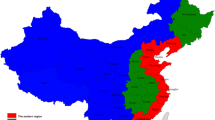Abstract
This study examined the efficiency of health care delivery systems in 24 OECD countries. Practicing physicians, practicing nurses, inpatient beds, and pharmaceuticals were considered as inputs to treat populations of various age groups. Data envelopment analysis (DEA) was utilized to calculate efficiency. We also calculated input efficiency that should be helpful in determining excess number of physicians, nurses, inpatient beds, and pharmaceuticals consumed. Institutional arrangements affect efficiency: public-contract and public-integrated countries are more efficient than public-reimbursement countries. Countries in which physicians are paid in wages and salaries and countries with capitation have higher efficiency than fee-for-service countries. Countries in which a primary care physician acts as a gatekeeper are also more efficient than countries without gatekeepers.
Similar content being viewed by others
References
Afriat SN (1972) Efficiency estimation of production functions. Int Econ Rev 13:568–598
Brockman H (2002) Why is less money spent on health care for the elderly than for the population? Health care rationing in German hospitals. Soc Sci Med 55:593–608
Charnes A, Cooper WW, Rhodes E (1978) Measuring the efficiency of decision making units. Eur J Operation Res 2:429–444
Chirikos TN, Sear AM (2000) Measuring hospital efficiency: a comparison of two approaches. Health Serv Res 34:1389–1408
Coelli TJ (1996) A guide to DEAP version 2.1: a data envelopment analysis (computer) program. CEPA working paper 96/8. University of New England: Armidale
Evans DB, Tandon A, Murray CJM, Lauer JA (2000) The comparative efficiency of national health systems in producing health: an analysis of 191 countries. GPE discussion paper series, no. 29, EIP/GPE/EQC, World Health Organization
Farrell MJ (1957) The measurement of productive efficiency. J R Stat Soc series A 120 part 3
Gerdtham UG, Jonsson B (2000) International comparisons of health expenditures: Theory, data and econometric analysis. In: Culyer AJ, Newhouse JP (eds) Handbook of health economics. Elsevier: Amsterdam
Grosskopt S, Valdmanis V (1987) Measuring hospital performance: a nonparametric approach. J Health Econ 6:89–107
Gupta SK, Verhoeven HM (1997) The efficiency of government expenditure: experiences from Africa. IMP working paper no. WP/97/15 International Monetary Fund: Washington
Leu RE (1986) The public-private mix and international health care costs. In: Culyer AJ, Honsson B (eds) Public private health services. Basil Blackwell: Oxford
Lovell CAK (2001) Production frontiers, productive efficiency. In: Fried HO, Lovell CAK, Martin AB, Whittle LS, Levit KR (eds) Trends in state health care expenditures and funding: 1980–1998. Healthcare Financ Rev 22, http://www.meps.ahrq.gov/data_pub/hc_fydata96.htm
Newhouse JP (1992) Medical care costs: How much welfare loss? J Econ Perspect 6:3–21
Newhouse JP (1977) Medical care expenditure: a cross-national survey. J Hum Resources 12:115–125
OECD (1992) The reform of health care: A comparative analysis of seven OECD countries. Health Policy Stud no. 2
OECD (1994) Health care reform: controlling spending and increasing efficiency. Economics Department working papers no. 149
OECD (2000) Health data 2000: a comparative analysis of 29 countries. Organisation for Economic Co-operation and Development: Paris
OECD (2000) Determinants of health outcomes in industrialized countries: a pooled cross-country, time series analysis. OECD Econ Stud 30
OECD (2001) Health at a glance. Organisation for Economic Co-operation and Development: Paris
OECD (2003) Health data 2003: a comparative analysis of 29 countries. Organisation for Economic Co-operation and Development: Paris
Roos NP, Montogomery P, Roos LL (1987) Health care utilization in the years prior to death. Milbank Q 65:231–254
Schmidt SS (ed) The measurement of productive efficiency Oxford University Press, New York
Seinford ABLM, Thrall RM (1990) Recent developments in DEA: the mathematical approach to frontier analysis. J Econometrics 46:7–38
Weisbroad BA (1991) Health care quadrilemma: an essay on technological change, insurance, quality of care and cost containment. J Econ Literature 29:523–552
Author information
Authors and Affiliations
Corresponding author
Rights and permissions
About this article
Cite this article
Bhat, V.N. Institutional arrangements and efficiency of health care delivery systems. Eur J Health Econ 6, 215–222 (2005). https://doi.org/10.1007/s10198-005-0294-1
Issue Date:
DOI: https://doi.org/10.1007/s10198-005-0294-1




